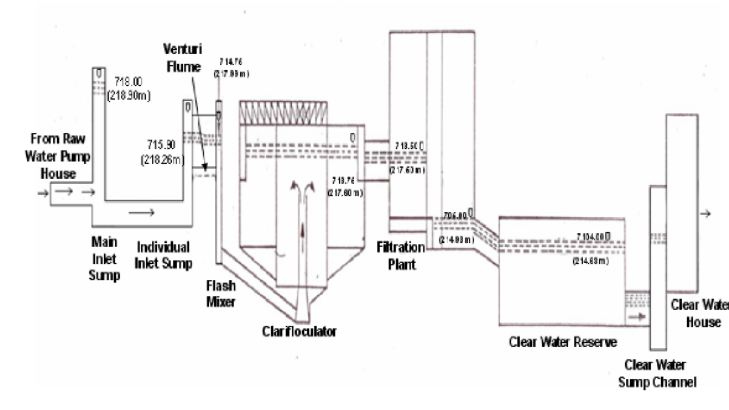On the occasion of World Water Day 2022, we are here to tell you the water story. How does the water from the glaciers, rivers, groundwater is tapped and brought to our houses as portable drinking water. We will trace the process through knowing about the processes at Asia’s largest Water Treatment Plant, located in New Delhi. Haiderpur Water Treatment plant is the single largest plant in Asia with a capacity of 200 MGD. It is located in Western Delhi on the outer Ring Road near Prashant Vihar, Rohini Sector 15 on the bank of Western Jamuna Canal originating from Tajewala Head Works Haryana. The plant is about 5km from GTKarnal Bypass and 4 km from Madhuban Chowk. It has two independent treatment plants of 100 MGD each.
The treatment flow scheme is the same for both. A common laboratory has been provided in the waterworks. Raw water is drawn from two sources, viz. the Western Jamuna Canal (WJC) and the Bhakra Storage. Western Jamuna Canal (WJC): – It originates from Tajewala Head Works, upstream Yamuna Nagar and then passes through Karnal, Munak, Panipat, Khubru, Kakroi and Bawana to Haiderpur Water Works. Bhakra Storage: Delhi Jal Board receives water from Bhakra Storage through Bhakra Nangal canal which joins WJC near Karnal and carries freshwater for Delhi Water Supply and serves the area such as Pitampura, Shalimar bagh, Saraswati vihar, Paschim vihar, Raja Garden, Jawala Heri, Ramesh Nagar and North West Delhi. This is approximately equivalent to serving around 18 Lakh of population.
The water treatment process in a Conventional Surface Water Treatment undergoes the following measures in order to provide us with potable water in our homes.
- Screening- This process includes removing large solids, logs, branches, rags, fish. It is a simple process and may incorporate a mechanized trash removal system. This process also ensures the protection of pumps and pipes in Water Treatment Plants.
- Coagulation- Small particles are not removed efficiently by sedimentation because they settle too slowly. It is easier to remove them if they are clumped together. Therefore they are coagulated to form larger particles or they may also pass through filters. In coagulation, a chemical such as alum is added. This sticks together the particles forming larger particles, which is more easily removed.
- Flocculation- Now the particles can stick together. The water is then allowed to flow into a tank with paddles that provide slow mixing and bring the small particles together to form larger particles called flocs. Mixing is done quite slowly and gently in the flocculation step. If the mixing is too fast, the flocs will break apart into small particles that are difficult to remove by sedimentation or filtration.
- Sedimentation- The next step in the process is the movement of water to a tank called a sedimentation basin, where gravity causes the flocs to settle to the bottom. Large particles settle more rapidly than small particles. It would take a very long time for all particles to settle out and that would mean we would need a very large sedimentation basin. So the clarified water, with most of the particles removed, moves on to the filtration step where the finer particles are removed.
- Filtration- The filtration apparatus is a concrete box that contains sand (which does the filtering), gravel (which keeps the sand from getting out) and underdrain (where the filtered water exits). After the filter is operated for a while, the sand becomes clogged with particles and must be backwashed. Next, flow through the filter is reversed and the sand and particles are suspended. The particles are lighter than the sand, so they rise up and are flushed from the system. When backwashing is complete, the sand settles down onto the gravel, flow is reversed and the process begins again.
- Disinfection- With particles removed, it only remains to provide disinfection, so that no pathogens remain in the water. Protozoan pathogens are large in size and have been removed with other particles. Bacteria and viruses are now destroyed by the addition of a disinfectant. Enough chlorine is added so that some remains go out in the water distribution system, protecting the public once the water leaves the plant.
- Distribution- Pumping of the clean water produced at the treatment plant to the community is called distribution. This can be done directly or by first pumping the water to reservoirs or water storage tanks.




